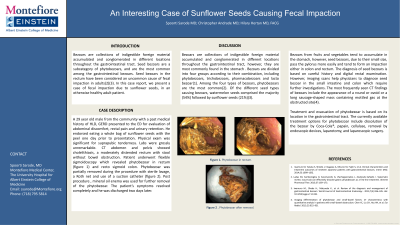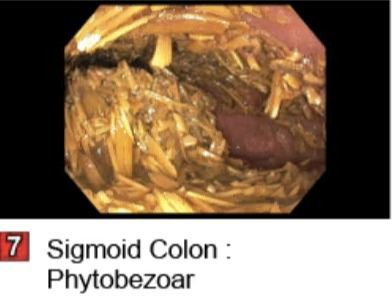Back


Poster Session D - Tuesday Morning
Category: Colon
D0120 - An Interesting Case of Sunflower Seeds Causing Fecal Impaction
Tuesday, October 25, 2022
10:00 AM – 12:00 PM ET
Location: Crown Ballroom

Has Audio

Spoorti Sarode, MD
Montefiore Medical center
Bronx, NY
Presenting Author(s)
Spoorti Sarode, MD1, Christopher Andrade, MD2, Hilary Hertan, MD, FACG2
1Montefiore Medical center, Bronx, NY; 2Montefiore Medical Center, Bronx, NY
Introduction: Bezoars are collections of indigestible foreign material accumulated and conglomerated in different locations throughout the gastrointestinal tract. Seed bezoars are a subcategory of phytobezoars, and are the most among the gastrointestinal bezoars. Seed bezoars in the rectum have been considered an uncommon cause of fecal impaction in adults. In this case report, we present a case of fecal impaction due to sunflower seeds, in an otherwise healthy adult patient.
Case Description/Methods: A 29 year old male from the community with a past medical history of HLD, GERD presented to ED for evaluation of abdominal discomfort, tenesmus and urinary retention. He endorsed eating a whole bag of sunflower seeds with the skin. Physical exam was significant for suprapubic tenderness. Labs were grossly unremarkable. CT abdomen and pelvis showed cholelithiasis, a moderately distended rectum with stool with no bowel obstruction. Patient underwent flexible sigmoidoscopy which revealed phytobezoar in rectum and rectosigmoid colon. Phytobezoar was partially removed during the procedure. Post procedure, mineral oil enema was used for further removal of the phytobezoar and to alleviate the patient’s symptoms.
Discussion: Bezoars are collections of indigestible foreign material accumulated and conglomerated in different locations throughout the gastrointestinal tract, however, they are most commonly found in the stomach . Bezoars are divided into four groups according to their combination, including phytobezoars, trichobezoars, pharmacobezoars and lactobezoar. Among the four types of bezoars, phytobezoars are the most common.
Bezoars from fruits and vegetables tend to accumulate in the stomach, however, seed bezoars, due to their small size, pass the pylorus more easily and tend to form an impaction either in colon and rectum. The diagnosis of seed bezoars is based on careful history and digital rectal examination. However, imaging scans help physicians to diagnose seed bezoar in the small intestine and colon which require further investigations. The most frequently seen CT findings of bezoars include the appearance of a round or ovoid or a long sausage-shaped mass containing mottled gas at the obstructed site.
Treatment and evacuation of phytobezoar is based on its location in the gastrointestinal tract. The currently available treatment options for phytobezoar include dissolution of the bezoar by Coca-Cola®, papain, cellulase, removal by endoscopic devices, laparotomy, and laparoscopic surgery.

Disclosures:
Spoorti Sarode, MD1, Christopher Andrade, MD2, Hilary Hertan, MD, FACG2. D0120 - An Interesting Case of Sunflower Seeds Causing Fecal Impaction, ACG 2022 Annual Scientific Meeting Abstracts. Charlotte, NC: American College of Gastroenterology.
1Montefiore Medical center, Bronx, NY; 2Montefiore Medical Center, Bronx, NY
Introduction: Bezoars are collections of indigestible foreign material accumulated and conglomerated in different locations throughout the gastrointestinal tract. Seed bezoars are a subcategory of phytobezoars, and are the most among the gastrointestinal bezoars. Seed bezoars in the rectum have been considered an uncommon cause of fecal impaction in adults. In this case report, we present a case of fecal impaction due to sunflower seeds, in an otherwise healthy adult patient.
Case Description/Methods: A 29 year old male from the community with a past medical history of HLD, GERD presented to ED for evaluation of abdominal discomfort, tenesmus and urinary retention. He endorsed eating a whole bag of sunflower seeds with the skin. Physical exam was significant for suprapubic tenderness. Labs were grossly unremarkable. CT abdomen and pelvis showed cholelithiasis, a moderately distended rectum with stool with no bowel obstruction. Patient underwent flexible sigmoidoscopy which revealed phytobezoar in rectum and rectosigmoid colon. Phytobezoar was partially removed during the procedure. Post procedure, mineral oil enema was used for further removal of the phytobezoar and to alleviate the patient’s symptoms.
Discussion: Bezoars are collections of indigestible foreign material accumulated and conglomerated in different locations throughout the gastrointestinal tract, however, they are most commonly found in the stomach . Bezoars are divided into four groups according to their combination, including phytobezoars, trichobezoars, pharmacobezoars and lactobezoar. Among the four types of bezoars, phytobezoars are the most common.
Bezoars from fruits and vegetables tend to accumulate in the stomach, however, seed bezoars, due to their small size, pass the pylorus more easily and tend to form an impaction either in colon and rectum. The diagnosis of seed bezoars is based on careful history and digital rectal examination. However, imaging scans help physicians to diagnose seed bezoar in the small intestine and colon which require further investigations. The most frequently seen CT findings of bezoars include the appearance of a round or ovoid or a long sausage-shaped mass containing mottled gas at the obstructed site.
Treatment and evacuation of phytobezoar is based on its location in the gastrointestinal tract. The currently available treatment options for phytobezoar include dissolution of the bezoar by Coca-Cola®, papain, cellulase, removal by endoscopic devices, laparotomy, and laparoscopic surgery.

Figure: Phytobezoar
Disclosures:
Spoorti Sarode indicated no relevant financial relationships.
Christopher Andrade indicated no relevant financial relationships.
Hilary Hertan indicated no relevant financial relationships.
Spoorti Sarode, MD1, Christopher Andrade, MD2, Hilary Hertan, MD, FACG2. D0120 - An Interesting Case of Sunflower Seeds Causing Fecal Impaction, ACG 2022 Annual Scientific Meeting Abstracts. Charlotte, NC: American College of Gastroenterology.
